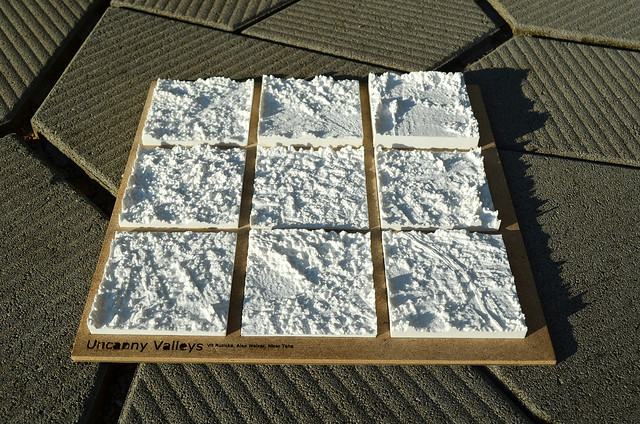Uncanny Valleys: Generative landscape (2019) We are able to generate endless non-existent variations of 3D patches of landscape using deep learning models trained on the features of Swiss landscapes. We have based the name of this project on the works of Ernst Jentsch “On the Psychology of the Uncanny” and by Masahiro Mori “The Uncanny Valley”, which characterize the “uncanny” as a mental state which occurs when one is not able to distinguish between the imagined and the real or between the dead and the living.
The field of Machine Learning has experienced a renaissance in Computer Vision tasks which have been lately applied in the field of Computational Arts as co-creative tools. Recent developments in architecture have seen the increase of use of 3D CAD/CAM solutions including robotic or digital fabrication. These advances in the field of Machine Learning allow us to generate new design suggestions or even to fuse designs across different domains. They are able to learn from natural patterns which took decades to form. Yet, we note that the fields of architecture, landscape, urban planning and construction haven’t taken these advances into its traditional processing pipelines.
We present a nontraditional approach of generating 3D landscape patches using the combination of a generative adversarial network (GAN) and a deep fully convolutional neural network (CNN) model with the U-Net architecture. In a novel experimental setup we have combined two machine learning models, each one having been trained on a separate dataset. While the Progressive GAN model synthesizes photorealistic aerial images, the U-Net model augments these with the height information finally producing 3D models. This separation treats both of these models as experts in their own domain of knowledge and circumvents the traditionally met difficulties with data representation, end-to-end generation of 3D models and the lack of appropriate training data. More concretely, we have trained a Progressively Growing GAN on a training dataset of aerial photographs and a U-Net model on the Topcoder Urban Mapper 3D dataset. We show that the non-existent generated landscape can be given additional meaning and interpretation in the form of additional dimension of height.
We expect that in the coming years these advanced computational tools will have great impact in our profession as designers, planners and architects. They will become common tools of co-creativity for us to make new objects, buildings and cities. This conceptual shift changes not only the way of how we produce architecture, but also the way how we think about it.
We conclude that our project is a novel, alternative approach to procedural landscape generation using current state-of-the-art GAN models. In this project we also explore the interaction of two independently trained models and their in-the-wild interactions.


